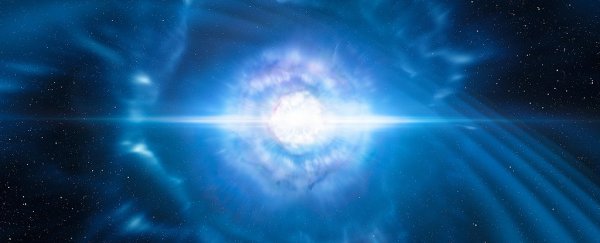For the first time ever, scientists around the world have managed to photograph a collision between two neutron stars, 130 million light-years away. The event is named GW170817.
And it's all thanks to gravitational wave astronomy, which identified the event and alerted observatories on where to look. So add to that list of firsts the first simultaneous optical and gravitational wave observations of the same event.
Can we have a party? Let's have a party.
Seriously, though, this is amazing. Never before have we been able to pinpoint where gravitational waves are coming from, or observe the event that caused them. And it's only the fifth gravitational detection ever.
The previous four detections were from collisions (or mergers) between binary black holes, coming together to form one big black hole. There were two main reasons we couldn't see them.
The first was that, until earlier this year, we only had two detectors – LIGO's interferometers in Livingston, Louisiana and Hanford, Washington. This meant that the first three events could be pinpointed only to a very broad area of sky.
The addition of a third detector, Virgo's interferometer in Italy, improved location accuracy by a factor of about 10, in the announcement of the fourth gravitational wave event just a few weeks ago.
The second was that black holes, by their very nature, are invisible. They absorb all light – we can only infer their existence based on changes in space around them. Neutron stars, on the other hand, are very visible, so a collision between them was a hotly anticipated event.
To make this new set of observations, around 70 ground- and space-based observatories joined LIGO and Virgo in examining a small area of the sky in the constellation of Hydra, right next to the lenticular galaxy NGC 4993.
The first detector went off on 17 August at 8.41am EDT.
Then, around 1.7 seconds later, two space-based observatories, NASA's Fermi Gamma-ray Space Telescope and ESA's INTErnational Gamma Ray Astrophysics Laboratory, picked up an intense gamma-ray burst – the brightest and most energetic events in the universe – from the same area of sky.
The "chirp" was different, too. These are the waves converted into audio data, and for black hole collisions, they last just fractions of a second. In GW170817, the chirp lasted around 100 seconds.
It wasn't a coincidence, and astronomers around the world made a mad dash to point their telescopes at Hydra.
"It immediately appeared to us the source was likely to be neutron stars, the other coveted source we were hoping to see - and promising the world we would see," LIGO spokesperson David Shoemaker said.
Neutron stars are one of the things that can happen at the end of the life-cycle of a supermassive star.
The core collapses, squeezing the protons and electrons into neutrons and neutrinos. The neutrinos escape, but the neutrons are incredibly densely packed into a core between just 10 and 20 kilometres (6-12 miles) in diameter.
If this core is less than about three stellar masses, the pressure of this density supports the neutron star. If the core is any larger, it collapses into a black hole.
The two neutron stars involved in GW170817 were between around 1.1 and 1.6 stellar masses, and they orbited each other in a shrinking spiral from a distance of about 300 kilometres, warping spacetime around them as they gathered speed, and sending ripples across the universe.
For the distance we're observing them from, the final collision was extremely bright, emitting an intense "fireball" of gamma rays. You can see it in the video below. Watch this. The big bright spot in the centre is galaxy NGC 4993. Just above and to the left, you can see GW170817.

Isn't that absolutely incredible? That is a collision between two neutron stars not much more massive than the Sun, 130 million light-years away, and you are seeing it with your own eyes.
But it gets even better. Remember we mentioned a gamma-ray burst?
"For decades we've suspected short gamma-ray bursts were powered by neutron star mergers," said Fermi Project Scientist Julie McEnery of NASA's Goddard Space Flight Center.
"Now, with the incredible data from LIGO and Virgo for this event, we have the answer. The gravitational waves tell us that the merging objects had masses consistent with neutron stars, and the flash of gamma rays tells us that the objects are unlikely to be black holes, since a collision of black holes is not expected to give off light."
And they also, once again, proved Einstein right.
"It … demonstrated that the speed of gravitational waves was the same as light to just a few parts in 10,000 trillion – verifying a central prediction of Einstein dating back to 1915," said Andrew Melatos of the University of Melbourne.
In the weeks and months ahead, observatories will continue to take observations of the collision to find out more about the kilonova. This is when the material that is left over from the collision, still glowing brightly, continues to be blown out into space.
Observatories and institutions around the world will also be releasing papers about this event. There are just so many aspects of it to be explored.
"From informing detailed models of the inner workings of neutron stars and the emissions they produce, to more fundamental physics such as general relativity, this event is just so rich," Shoemaker said.
"It is a gift that will keep on giving."
Find out more in the Veritasium video below:

The LIGO-Virgo results have been published in the journal Physical Review Letters.
